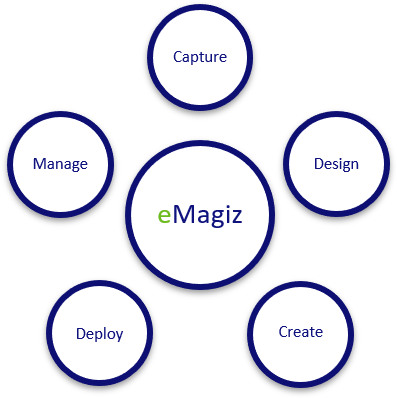The five phases of eMagiz
Understanding the structure of the eMagiz platform is important to unlock its full potential. This microlearning will guide you through the five phases of eMagiz: Capture, Design, Create, Deploy, and Manage. Each phase plays an important role in the integration process, helping to connect business and IT seamlessly. Use this guide as a reference to clarify the purpose and function of each phase within eMagiz, ensuring a smooth and efficient integration experience.
Should you have any questions, please contact academy@emagiz.com.
1. Prerequisites
- Basic knowledge of integrations in general
2. Key Concepts
In this microlearning, we will focus on the five phases that eMagiz consists of. eMagiz consists of the following five phases:
- Capture
- Design
- Create
- Deploy
- Manage
Each phase has a specific function within the platform. We will discuss the specific function per phase in this microlearning.
You can use this microlearning as a reference if you are unsure what a specific phase within eMagiz exactly does.
3. Business to IT
Integration can be regarded as something that is privy to the Developer savvy people, but eMagiz provides a unique way to connect IT people with the Business people using a platform that allows to create integration fast, capture the integration and associated business process inside the platform, and make the complete technical infrastructure transparent for both business and IT people involved.
The eMagiz platform uses the Integration Lifecycle Manager as guidance to create integrations with.
Capture
- In this phase, the involved systems and integrations are drawn into a canvas. The canvas provides insight into the integration landscape including all systems involved, direction, and naming. This canvas is viewable throughout the entire platform. All technical requirements and descriptions can be stored here making external documentation unnecessary. It is considered best practice to fill out the documentation available in capture to ensure smooth development throughout the next phases. Incomplete documentation could result in backtracking and unnecessary rework.
Design
- In this phase, all the definitions of the system messages are created, and associated transformation mappings are drawn. This phase is next to the previous phase, very important and often handled by experienced staff. In this phase connectivity and the data model are designed together with the architecture for the integration(s). In this phase, the client infrastructure is determined and different required components are spread across the cloud. It also provides insight for architects regarding the sizing of cloud components.
Create
- In this phase, the integration is automatically generated based on the settings defined in the Capture and Design phases. The integration is divided up into one or more individually generated flows which are complemented with default low-code building blocks that you can finetune to reach the expected results. The flows also includes unit test functionality to speed up the development process. This enables you to quickly test your flow without the need to deploy your flow.
Deploy
- In this phase, the integration model from the 3 previous ILM phases is deployed using release management functionality and deployment plans that can run automatically. The deploy phase also contains functionality to see what components are running where the live status of the flow and allows influencing the properties under which the flows are running.
Manage
- In this phase, the integrations can be seen from monitoring and alerting perspective. Running integrations that produce errors are displayed, runtime components have specific logging that is also displayed here. All these elements can generate alerts that can be sent to involved staff and support systems.

4. Key takeaways
- eMagiz allows business and IT people to work jointly to create integrations
- eMagiz is a comprehensive platform that allows ad-hoc integrators to perform all required activities to run the platform
- The ILM phases are key in the way of work in eMagiz.
